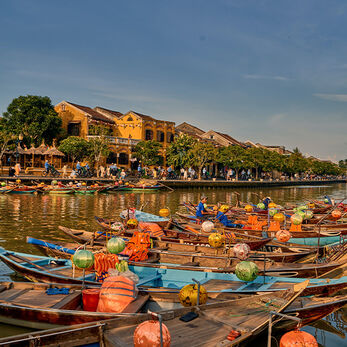Vietnam's cultural heritage is vividly encapsulated through its designation of 294 national treasures, each representing a distinct facet of the nation's historical and artistic journey. These treasures not only reflect the depth of Vietnam's past but also highlight the exceptional craftsmanship that defines its artistic traditions. Among these treasures, ten artifacts stand out as exemplary representations of Vietnam's historical and artistic excellence. These selected pieces, ranging from intricate sculptures and ancient inscriptions to exquisite ceramics and paintings, offer a profound glimpse into the country's illustrious history and its enduring artistic legacy. Each artifact showcases unique aspects of Vietnam’s heritage, contributing to a broader understanding of its cultural evolution.

The cobalt blue pattern ceramic jar with swan decoration was the first antique porcelain piece recognized as a National Treasure of Vietnam in 2012. This jar, discovered in a shipwreck off Cu Lao Cham Island between 1999 and 2000, is now housed in the National History Museum in Hanoi. It exemplifies Vietnamese cobalt blue ceramics, which began in the 14th century and reached its zenith in the 15th century. The jar features intricate designs with swans and various floral and landscape patterns, showcasing the high craftsmanship and export quality of Vietnamese ceramics. Analysis indicates it was produced in the Thang Long kilns. This artifact is a notable example of traditional Vietnamese ceramic art and provides valuable insights into the history and trade of Vietnamese pottery.

The Ngoc Lu drum is a significant artifact from the Dong Son culture of the Bronze Age, dating to around the 2nd to 3rd century BC in Vietnam's Red River Delta. Discovered accidentally in 1893 in Hà Nam Province, it was the first item listed among Vietnam's National Treasures in 2012. The drum features richly decorated concentric panels, depicting ceremonial scenes, musical instruments, and various activities such as rice cultivation. Its intricate design includes images of feathered figures, possibly performing a ritual or festival, and highlights the advanced artistry and ceremonial life of the Dong Son civilization.

The Dong Duong Buddha statue is considered the oldest and most beautiful Buddhist artifact in Southeast Asia. Housed at the Vietnam History Museum in Ho Chi Minh City, this bronze statue, discovered in 1911 by French archaeologist Henri Parmentier, represents the highest craftsmanship of the Champa civilization. Weighing 120 kg and standing 119 cm tall, the statue features intricate designs, including scenes of rituals and detailed depictions of Buddha's physical attributes. The statue not only showcases exceptional artistic skill but also embodies numerous auspicious signs described in Buddhist texts. The Dong Duong Buddha is a key cultural treasure, reflecting the rich heritage of Champa Buddhism and its artistic achievements.

The Devi Goddess Statue (Hương Quế) is a sandstone sculpture from the 10th century, measuring 38.5 cm in height and 21 cm in width. It depicts a finely detailed bust of the Hindu goddess Devi, featuring a graceful and refined face with long, curved eyebrows, large eyes, a straight nose, and a slight smile. The goddess's high coiffure is adorned with a crescent-shaped ornament, and her bare, rounded chest conveys a sense of vitality and sanctity. This statue, preserved at the Ho Chi Minh City History Museum, is renowned for its artistic beauty and significance in Champa culture. It represents Haradevi, the wife of King Indravarman II, who was honored with this statue due to her virtues. The Devi statue is celebrated globally as an emblem of Champa and Vietnamese heritage.

The Vishnu Statue is a bronze sculpture from the 3rd to 5th century, measuring 23 cm in height and 11 cm in width. It depicts Vishnu, a major Hindu deity, standing on a pedestal and wearing a cylindrical crown. The statue features four arms: two holding a conch shell (Shanka), a symbol of the origin of life, and a globe (Bhu) representing the Earth, while the other two hold a long mace. Vishnu is draped in a long dhoti. This well-proportioned and aesthetically distinctive statue represents Vishnu's role as the preserver and protector of life, as well as his role in vanquishing evil. It is a prominent artifact of the Oc Eo culture and is displayed globally to represent Vietnamese heritage. The statue is housed at the Ho Chi Minh City History Museum.

The My Son E1 altar is a significant artifact from the My Son Sanctuary in Vietnam, crucial for studying the cultural, religious, sculptural, and architectural aspects of the Champa Kingdom. It represents the My Son E1 style, which marks the beginning of the local adaptation of foreign influences. This Champa altar, unique for its detailed depictions of Hindu priests and natural scenes, is notable for its large size and intricate carvings, which include motifs of daily life, animals, and religious activities. Discovered in 1903 and reconstructed from 16 sandstone blocks (with 2 missing), the altar dates back to the 7th-8th century and is housed at the Cham Sculpture Museum in Da Nang, Vietnam. Recognized as a national treasure in 2012, it provides valuable insights into Champa society and religious practices, and it continues to be a highlight of the museum's collection.

The Amitabha Buddha of Phat Tich Temple is a stone sculpture from the Ly Dynasty, considered one of Vietnam's most significant and exemplary Buddha statues. The statue, standing at 1.86 meters tall (or 2.69 to 2.77 meters including the pedestal), was originally gilded but lost its gold layer over time. Dating back to 1057, it was erected by King Ly as part of a temple and pagoda on Mount Lan Kha. Although damaged during the French colonial period and later restored, it remains an important artifact from the Ly Dynasty. The statue features a serene, elongated face, a prominent ushnisha, and is seated in the lotus position on a pedestal decorated with lotus petals and dragons, symbolizing Buddha's power over fierce beasts. The statue is preserved in the Phat Tich Temple in Bac Ninh province, and has replicas displayed at the Vietnam History Museum and the Vietnam Fine Arts Museum in Hanoi.

The Cửu Đỉnh (Nine Cauldrons) of the Nguyễn Dynasty are nine large bronze cauldrons placed in front of the Thế Miếu (Temple of the Forefathers) in the Imperial City of Huế. Commissioned by Emperor Minh Mạng in 1835 and completed in 1837, these cauldrons were inspired by ancient Chinese models and symbolize the stability and longevity of the Nguyễn dynasty. Each cauldron is inscribed with intricate designs depicting various aspects of Vietnamese geography, flora, and fauna, and their names correspond to the reign names of different Nguyễn emperors. They were meticulously crafted using bronze and zinc, reflecting both artistic and technical mastery. Despite the turmoil and wars that followed, the cauldrons have remained intact and continue to be a significant historical and cultural symbol.

"Vườn xuân Trung Nam Bắc"(literally Spring Garden of the Central, South, and North Regions) is a masterpiece of Vietnamese lacquer art created by renowned artist Nguyễn Gia Trí. This artwork represents a culmination of over fifty years of exploration and innovation in lacquer art. The painting, completed over a record-breaking 20 years, depicts the spring season and showcases traditional attire and scenes from the three regions of Vietnam: North, Central, and South. Despite the substantial cost and personal sacrifices made during its creation, including health issues faced by Trí, the painting reflects his artistic zenith. It features intricate use of lacquer techniques and materials like gold, silver, and eggshell, enhancing its elegance. Initially controversial for its high purchase price, it was eventually recognized as a national treasure and remains a celebrated symbol of Vietnamese artistic heritage. Despite some damage during a restoration attempt, it continues to shine as a proud representation of Vietnam’s cultural and artistic legacy. The painting is currently housed at the Ho Chi Minh City Museum of Fine Arts.

Em Thuý, literally "Little Sister Thuy" is a notable oil painting by Vietnamese artist Trần Văn Cẩn, created in 1943. The painting depicts his 8-year-old niece, Nguyễn Minh Thúy, and is celebrated as one of Cẩn's finest works and a significant 20th-century Vietnamese portrait. Featuring Thúy in white clothing and a shy demeanor, the portrait captures her innocent expression. Recognized as a 'National Treasure' by the Vietnamese government in 2013, the painting was initially lost during the First Indochina War but later recovered and restored. It is now housed at the Vietnam National Museum of Fine Arts in Hanoi, where it continues to be admired for its artistic and historical value.
These ten national treasures not only highlight Vietnam's historical richness but also underscore its artistic excellence. Each artifact offers a unique perspective on the country's cultural evolution and craftsmanship, contributing to a comprehensive understanding of Vietnam’s illustrious heritage. Through these treasures, we gain profound insights into the artistic and historical legacy that defines Vietnam.






